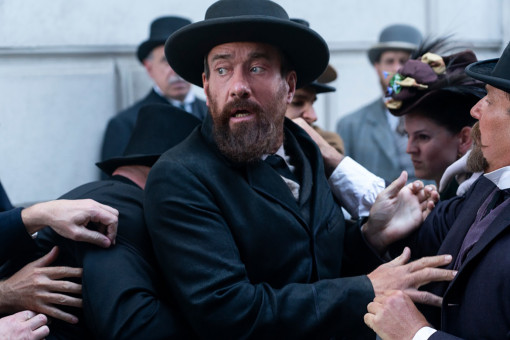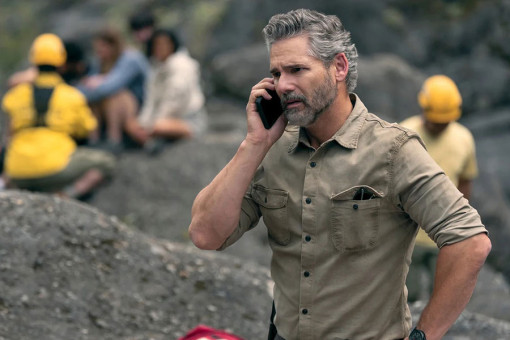“That's a scene that I don't think you would ever be able to do in a movie.”
The scene that Steven Zaillian refers to is in the first episode of his gripping Netflix limited series, Ripley, where scammer-turned-multiple-murderer Tom Ripley (Andrew Scott) shakes down a middle-class New Yorker for a few bucks by posing as a representative of a collection agency calling this gullible mark about a late bill. The Emmy-nominated writer-director — and Oscar-winning screenwriter of Schindler’s List — feels that scene would have been verboten in a screenplay due to its length and intentionally minimalist execution.
“It was probably written as a 10-page scene of a guy on a telephone,” Zaillian tells the Television Academy in an exclusive interview. “The scene is shot from very far away, for the most part. It’s a very static, deliberate scene that lets us see how Tom’s brain works, how he sees the world. Who he values in it. When I started this project, I felt that I was going to embrace that sort of idea.”
Other ideas he embraced — which eight episodes of television could accommodate more effectively than a movie’s feature length — include the process by which the title character of Patricia Highsmith’s 1955 novel The Talented Mr. Ripley goes about not just murdering those in his orbit, but how he would proceed in getting rid of their bodies. “If we were going to do this, it was important to Steven to ask and answer the question: How would you really go about disposing of a body?” explains Ripley cinematographer Robert Elswit, who shot Tom’s homicidal tour through exotic Italian locales in stark black and white to better capture the “crime and punishment” exploits Tom gets involved in — and narrowly gets out of.
One pivotal sequence showcases Zaillian and his team’s creative efforts to capture the nail-biting, slow-burn tension of Tom Ripley’s fatal dark side: the bloody murder of Tom’s friend and scion of a shipping magnate, Dickie Greenleaf (Johnny Flynn), and the harrowing aftermath of disposing his body at sea after Tom loses control of the boat that ferried Dickie to his watery grave.
Zaillian reveals how he and his production team helped their main character get away with murder, which bits involving Dickie’s brutal death didn’t make the final cut and the inventive way the show uses the end credits of each episode to “preview” future installments.
Television Academy: Dickie’s murder — and Tom’s attempt to cover up the crime in ways that almost get him killed — is full of white-knuckle tension. How did you devise that sequence on the page, and how much changed in the production and editing of that sequence?
Steven Zaillian: Well, believe it or not, it was even longer in the script. What didn't make it was things like, “Oh, what if he has to refill the lighter?” You know, the lighter runs out of fluid, and Tom has to get gas and pour it. Things like that, the little details. But these set pieces, the one in episode three and the one in episode five [in which Tom murders Dickie's friend Freddie Miles, played by Eliot Sumner], they were both things that I felt was another essential reason to do this story, to adapt this story, in this form. Because the book spends a lot of time in these scenes. And I probably spend even more time with them. But this idea of seeing the reality of how you try to dispose of a body was interesting to me, and I didn't think that I'd ever seen it to this degree.
For you, as as a writer-director, I assume it’s a fun challenge just in terms of how to visualize and depict a largely dialogue-free sequence.
As a director, it's fun, because it's pure visual storytelling. It's not relying on any dialogue. So it was something that I cared a lot about, and I spent a lot of time in the writing, and then when we were shooting it, because I felt they were important. And we shot the killing of Dickie in this pool — a large swimming pool in Rome. Elswit and his crew, they did a fantastic job using silks to block out the sky. We also use some greenscreen for some sky and water effects.
So the boat, when Tom loses control of it, it’s not moving?
The boat mostly stayed stationary, yes. But there are a few shots when it’s moving.
Did you do extensive storyboarding or pre-viz for this sequence?
We did for part of it. We actually did the whole thing. The main reason that we needed to do that was for the part where the boat is out of control.
You establish early on that this is a show rooted in the tension that comes from the process of things, and our first introduction to Tom is when he dupes some poor guy over the telephone into paying a late fee on a bill that he already paid.
That’s a scene that I don’t think you would ever be able to do in a movie. At least not that particular way.
How so?
Well, it was probably written as a 10-page scene of a guy on a telephone. The scene is shot from very far away, for the most part. It’s a very static, deliberate scene that lets us see how Tom’s brain works, how he sees the world. Who he values in it. When I started this project, I felt that I was going to embrace that sort of idea. And it was very important to me who was on the other end of the phone, that it was an actor and not somebody just reading off-camera lines. And it's an actor that you might remember from [Zaillian’s 1993 feature directorial debut] Searching for Bobby Fischer. His name is Steve Randazzo; he was one of the parents that gets into a fight at one of the chess matches. [Steve] was in New York on the telephone at three in the morning when we were shooting. So I think we were getting off on the right foot in terms of realism on how we approached the scenes.
When you started this project, did you also have in mind teasing a preview of the next episode by playing audio from the next installment over the previous one’s closing credits? Or was that something you came up with later?
I thought it'd be interesting, instead of, you know, having visuals [teasing] the next episode, we’d just do it with sounds. And so we did, and it was fun. These days, it’s hard to watch credits, because they switch off so quickly and roll you into the next episode. So, I do hope people will watch them, not just because the people involved are being mentioned, but also because there's something else going on there.
This interview has been edited for length and clarity.
All eight episodes of Ripley are now streaming on Netflix.
















